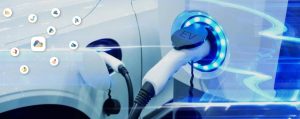The effect of the global crisis on the automotive industry is no news, and is clearly reflected in the data of the latest reports:
- Sales at dealerships decreased.
- Sale prices per unit dropped, both in new and used vehicles.
- The gross margin on the Price of new vehicles fell.
- Dealerships suffer net losses for each used vehicle sold.
Therefore, it is important for CEOs and departmental managers to closely monitor the condition of the dealership.
Luckily, the DMS offers plenty of accessible information. But… from the hundreds of reports in your DMS, what you should be monitoring?
Our team of experts made a list with the KPIs or Key Performance Indicators that managers should analyze periodically that we share below.
KPI #1: Absorption rate
Vehicle sales are falling and the margin per vehicle is dropping year by year.
At the same time, many CEOs tend to focus the business on sales, which is the sector they come from. A lot of dealers recognize the importance of Parts and Service, but they prefer not to get involved.
It is vital for dealers to focus their efforts on achieving maximum efficiency in Parts and Services. One way to control this is by monitoring the Absorption rate.
What is the Absorption Rate?
The Absorption Rate is the percentage that the Parts and Service departments cover (or “absorb”) from the total operational costs of the dealership.
Formula
(Parts and Service sales – Parts and Service variable costs) / Total expenses of the dealership
Therefore, this is the challenge: an efficient dealer should sell enough parts and services so as not to depend on vehicle sales.
Ideally, a dealer will have an Absorption rate of 1, that is, Parts and Service will generate enough profit to cover the total fixed expenses of the entire dealership.
Let’s analyze three things dealers can do to improve the Absorption rate:
- Increase the efficiency of the Service department. There are several indicators to consider, including Hours by Repair Order and the Parts vs. Labor relation or ratio.
- Implement an effective strategy for managing parts inventory to optimize purchases (and thus reduce costs), improve availability, and reduce lost sales.
- Follow-up customer backorders. This point is often overlooked and can affect purchases, sales, and customer satisfaction.
Peter Drucker once said, «You can’t manage what you can’t measure. » Given the current economic situation, it is more critical than ever for managers to monitor the health of the dealership. Luckily, today’s dealer management systems offer plenty of information that is easy to obtain … but what exactly you should be monitoring?
Fortunately, modern management systems provide very useful reports. In this series of articles, we want to help you separate the wheat from the chaff so you can focus on the key performance indicators you should monitor.
KPI #2: Obsolete parts inventory
Parts inventory management is a very difficult task due to the number and great variety of parts that a dealer must handle nowadays.
The dealer must deal with two conflicting situations: having a good parts fill rate and, on the other side, achieving a high turnover of parts inventory.
From a commercial point of view, a high parts fill rate avoids lost sales and increases customer satisfaction. But achieving this may imply having too many parts in stock, especially if you do not buy the right parts.
Inaccurate purchases can generate a problem that will progressively increase if you do not put a curb on it: the increase in the dead inventory.
What is the obsolete parts inventory?
We consider obsolete parts inventory (also called immobilized or dead inventory) the parts inventory without sales in the last 12 months.
Many dealers are surprised when they measure their obsolete inventory for the first time because it can stand for 50-70% of the total inventory, and sometimes even more, as a consequence of many years of buying intuitively instead of statistically.
The first reaction is always the same … disbelief. But numbers do not lie, and once they understand this, dealers can proceed to solve the situation with a dual strategy: (i) decide what to do with the obsolete parts, and (ii) apply an effective parts ordering strategy.
What is the cost of this problem?
The obsolete inventory generates direct and indirect costs, for example:
1. Opportunity cost
The dead inventory is money on the shelves that do not generate any profit. In other words, it is equal to the opportunity cost of investing that money in another business.
Imagine a dealership with a total parts inventory of $1,000,000 from which $500,000 are obsolete parts, and suppose a bank could pay an annual interest of 18% on deposits. In this case, the dealer has an opportunity cost of $90,000 per year for this dead inventory.
2. Direct loss
Ultimately, parts that become obsolete will have to be scrapped or sold at values much lower than cost, which implies a direct loss. In our example, if the dealer manages to sell the obsolete parts at 50%, the loss would be $250,000.
3. Hidden costs
Dead inventory implies several direct costs, such as insurance, “rent” of the storehouse (even though the dealership owns the warehouse, this cost must be considered), taxes, and time spent on every inventory count.
Solutions to the problem
Your dealer management system surely offers several tools that can help you.
1. Parts ordering methods
It is important to start purchasing based on statistic methods, using computerized order suggestions. An effective parts ordering strategy considers topics such as sales ranking, volume of demand, popularity, and seasonality.
2. Monitor the health of the inventory
It is vital to monitor the health of the inventory periodically, using High-to-Low Crosstab Reports, and immediately apply the appropriate corrective actions.
3. Improve management of customer backorders
When the manufacturer sends parts, it is difficult to determine whether they are for stock or to satisfy a customer order.
If a customer requested the parts but does not come back for them, these parts may remain to gather dust on the shelves and will soon be part of the dealership’s dead inventory.
The dealer must load all the customer orders into the system, and the software should inform the customer that requested each part when parts arrive from the supplier. The system should also help with a review policy to check the age of the customer backorders.
A bad cycle of collections and payments is one of the main reasons why companies fall into a financial crisis.
KPI #3: Accounts Receivable Turnover … How much money do you have on the street?
Many dealers work with installment sales (sales on open account) in their parts and service departments, and the truth is that few dealers really know how much money they have “on the street” at a given time and how this could affect them.
This information is essential when planning and for using the company´s resources efficiently.
The Accounts Receivable Turnover indicator helps the company see the time it takes to recover customer accounts receivable.
Formula
(Accounts Receivable * 360) / Net Credit Sales
Suppose the dealership had annual installment sales of $10,000,000, and at the end of the period $3,500,000 remain uncollected. The formula throws a result of 126, which are the days it takes to collect the installment sales.
This indicator can show that the dealer is financing customers with better terms than the ones obtained from suppliers, producing a financial disadvantage. In other words, if the dealer finances customers for 126 days but suppliers finance the dealer only for 30 days, the company can run out of liquidity to face payments at any time.
If this happens, the dealer will have to resort to alternative financing sources (bank loans, overdrafts, check sales) with their respective costs.
And let’s not forget that money on the street is immobilized money the dealer could use in service improvements or new investments.
Subscribe to Our Newsletter
You will receive best practices, new articles, webinars, trainings, updates and more!
» Subscribe
Accounts Receivable Turnover as a strategy
The Accounts Receivable Turnover indicator should comply with the goals of the dealership.
Based on the payment terms granted by suppliers, the dealer should perform a projected cash flow to simulate different collection and payment terms to analyze their financial impact.
Based on these scenarios, the dealer can plan different strategies:
- If you are in a customer acquisition stage, you can use a high Accounts Receivable Turnover rate to seduce them with good financing.
- If the goal of the dealership is greater liquidity, you will try to obtain a low rate; for this, you can create a strict policy to retain only those customers who are good payers.
The fact that the Accounts Receivable Turnover rate is high or low is not the problem. The point is to always have it under control and that this rate is consistent with the goal of the dealership.
It is also important to remember that shortening collection terms is like a financing source for the company at a lower cost than applying for a bank loan.
And the other side of this is that, if the dealer does not charge any interest to the customers for selling on credit, it is the same as investing in resources with zero profitability.
With the right tools, the dealer can proactively set an Accounts Receivable Turnover goal instead of reacting to improve it.






